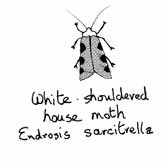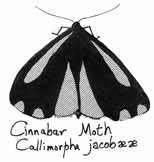|
|
|
| Colney Nature Watch |
| A series of articles on the wild life in London Colney |
| Moths |
 |
As a boy, each autumn we'd
take our winter woollies from the wardrobe, to find them covered with
holes. The culprit was the clothes moth! We don't see them so often these
days, as they dislike fabrics containing man made fibres.
This year, there've been lots of white shouldered house moths in my house.
Its wings are bronze coloured, with dark brown splodges symmetrically
placed. Outside houses, they usually live in the nests of birds, squirrels,
and mice, eating vegetable detritus.
|
| There are over 3000 species of
moth living in Britain. Most are dull coloured and fly at night: but not
all! The Wood Tiger has its front pair of wings cream, with dark brown splodges,
and the rear wings orange and black. Five British moths have a name containing
the word 'tiger'. The old de Havilland factory at Hatfield once built a
biplane trainer plane - called the 'Tiger Moth'. Geoffrey de Havilland was
an amateur entomologist, and named several of his planes after favourite
moths. One of my favourite moths is the back and scarlet Cinnabar Moth.
Its caterpillars eat the leaves of the poisonous ragwort weed. They in turn
become poisonous. A bird eats the orange and black caterpillar, or the adult
moth - and remembers feeling ill - so it never eats another! |
 |
A species common all over
southern Britain is the peppered moth. Any batch of their eggs will contain
individuals who grow into dark brown moths, or white, with scatterred
grey spots. Victorian scientists noted the brown variety was commonest
in industrial areas, where most surfaces were brown, and the white variety
was more visible to foraging birds. They also noted that in rural areas,
it was the white variety that was more common ~ and this was an example
of evolution in action.
|
|
People ask - what is the difference
between butterflies and moths? The French, German and Spanish words for
moth are papillon de nuit, Nachtfalter and mariposa nocturna. This hints
at a popular misunderstanding, moths do not all fly only at night! Butterflies
more often perch with their wings vertically above their bodies - particularly
in the morning, when they want the sun to warm their blood. But so do
many moths! Most moths have feathery antennae, so they can home in on
distant food plants. Most moths have hairy bodies, to keep them warm at
night - but so does the Apollo Butterfly, - a white butterfly with red
discs with black outlines on its wings - which frequents alpine pastures
in Italy and Austria. The only true difference between butterflies and
moths is that moths have a small hook linking their front and back wings-
so they beat together.
|
 |
Some moths are a nuisance!
There are moths which specialize in eating nothing save crops we grow:
there are 25 species of Raspberry Moth, several species of apple and pear
moth . . . However, many moths, in their search for energy food i.e. nectar,
visit flowers, and in the process transfer pollen from one flower to another
- helping fertilize them. Moths provide food for birds and small mammals.
Moths are interesting in their own right - it is a pity people do not
realise what a wonderful variety of moth there are to be seen.
|
|
If you really want to see
lots of moths, lay a white sheet on the ground in a leafy forest. Put
stones down, to stop it blowing away, and train some bright lights on
the sheet. Somewhere on the sheet, place a saucer, with water containing
a little honey. If it is warm, after a while you'll find lots of moth
- but beware - many moth do not like-the
smell of humankind!
|
|
|
|




